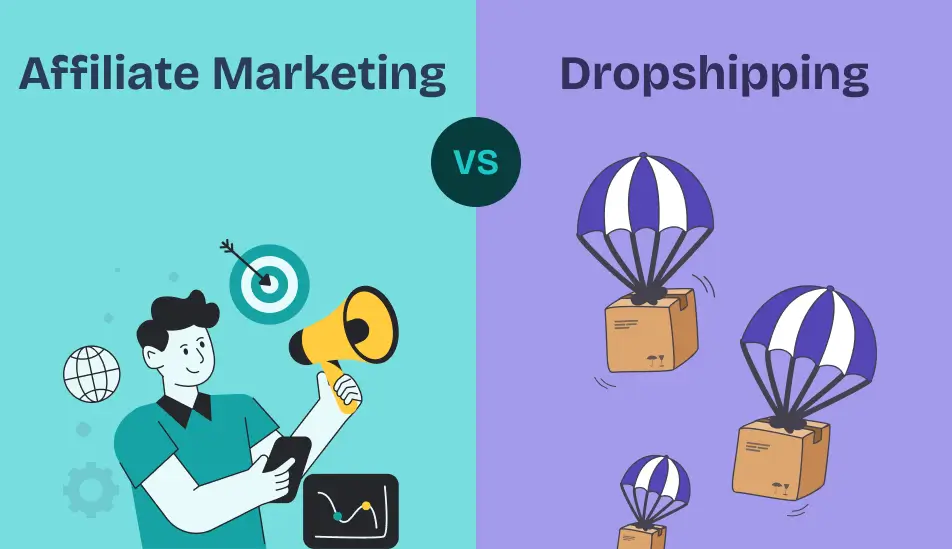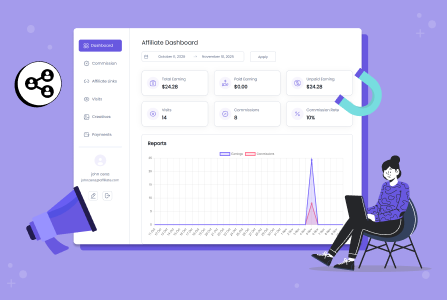Affiliate Marketing vs Dropshipping: Which is Best for You?

- What Business Model is Behind Affiliate Marketing vs Dropshipping
- Affiliate Marketing vs Dropshipping: Workflow & Cost
- What is Easier to Start?
- Affiliate Marketing vs Dropshipping: What is More Profitable?
- Alternatives for Dropshipping and Affiliate Marketing Business
- Concluding - Dropshipping or Affiliate Marketing?
If you are deciding which eCommerce capabilities and online business models are best suited to you for starting an online project, we’re here to help. When among all the options, you’ve stopped on affiliate marketing or dropshipping, there is a nice list of things to consider. Let’s compare the pros and cons of both strategies!
What Business Model is Behind Affiliate Marketing vs Dropshipping
There is a different business model and nature in these business activities, even the ‘middleman’ role can be applied to both.
Dropshipping involves selling physical products from suppliers without holding inventory, so it deals with the actual clients and actual products. You will basically work as a normal online store that buys, sells, and ships products, as well as deals with client communication and all the troubles that might happen.
When it comes to affiliate marketing, you promote other companies’ products and earn a commission per sale, but you don’t directly deal with those customers, nor do you buy or ship products.
At first sight, the second approach might sound easier, but let’s dive deeper to confirm or refute our hypothesis.
Affiliate Marketing vs Dropshipping: Workflow & Cost
There is a different knowledge and set of skills needed, as well as different kinds of enjoyment you take in the workflow.
When you are working with dropshipping, then product sourcing, e-commerce (e.g. using website builder tools to build an online store), customer service, and fulfillment are top things you need to know. Think of it more as a pragmatic and practical task.

In short, your workflow in dropshipping includes:
- Setting up an online store (installing your site on your hosting, the basics of web technologies and payments for e-commerce sites).
- Finding partners with suppliers.
- Managing orders and customer service.
- Running paid ads or SEO to get traffic.
Arguably, affiliate marketing is a more creative pursuit. Content creation, SEO, social media marketing, and persuasive writing or video/audio content creation are your top future routines if you choose this approach. Also, you’ll need to communicate directly with brands and negotiate deals related to affiliate commissions. Let’s list them to give you the idea of the workflow:
- Build a website, blog, or social media presence.
- Create content to promote the products or services of your affiliates.
- Register in the affiliate program of the brands to get affiliate links.
- Drive traffic to merchant sites through your content through promotion and SEO.
Of course, think of the experience you already have to choose a more suitable model.
What is Easier to Start?
It’s a hard question. Upfront costs are normally higher when you are starting a dropshipping business – you need to choose an e-commerce platform, and pay for a website, advertising, and apps. You need a lot of time to choose and list products, as well as negotiate deals with partners. Over time, you might need a CRM to manage clients and payments.
Starting as an affiliate marketer is easier. At the beginning, it can be just a blog, even on a third-party platform or YouTube. Social media is also free to start. In some cases, when you have a content plan or loads of ready-to-go content to be published, it might make sense to start independently with your site, for example, WordPress, the most chosen website-building platform in the world.
In both cases, extensive resources for marketing are required. Think of paid advertising (Facebook Ads, Google Ads, TikTok Ads), your brand logo design, social media, SEO, content marketing, and email marketing. More or less of those are usually part of your routine, no matter if you are in dropshipping or affiliate marketing.
You can start either without prior knowledge, but dropshipping, as a rule, has a steeper learning curve and may require more time to get experience in this niche.
| Tasks | Dropshipping | Affiliate marketing |
| Website setup | Requires a full eCommerce store (Shopify, WooCommerce). | Can start with a simple blog or social media. |
| Product research | You must find profitable products and reliable suppliers. | Pick a niche and join affiliate programs. Not all affiliate systems can accept you. |
| Order fulfillment | Coordinate with suppliers, handle refunds and shipping. | No fulfillment or logistics to manage. |
| Customer service | Handling customer complaints, refunds, and chargebacks. | No customer service. |
| Marketing | Paid ads (Facebook, TikTok, Google Ads). | More focus on free traffic (SEO, social media, email) that takes time to create. |
Affiliate Marketing vs Dropshipping: What is More Profitable?

As you may conclude from the table above, you can start making money quickly with ads if you’ve built a site for dropshipping, but it works only if your ads are effective and the audience you target is a suitable one. It’s easier to scale a dropshipping business and become profitable with the help of automation tools and assistants.
Risks of dropshipping:
- Since you are a middleman, you don’t own the products you’re selling, or how they get made and shipped, so you can’t build a long-term brand. This can be risky because when your supplier decides to raise their prices, stop working with you, or just disappear.
Affiliate marketing is a longer-term play. It might take months and even years to grow traffic before earning commissions. The risks are low, but you might lose a lot of time in vain if you can’t manage website promotion. You may also try paid ads to promote content created for affiliates faster. Your business starts scaling and making you money once your content is ranked high in search engines and AI searches.
Risks of affiliate marketing:
- Some brands have strict rules for being accepted into their affiliate marketing programs. If you create a lot of content about them but are later rejected, you lose time and resources. More than that, some brands may disable your affiliate account over time, so it’s important to diversify your partners.
- Only content that gets enough traffic can generate sales and commissions, and getting traffic in the saturated web space is a hard task.
Alternatives for Dropshipping and Affiliate Marketing Business
While you are choosing between dropshipping and affiliate marketing, remember not to put all eggs into one basket and consider more options you can be doing at the same time:
- Print-on-demand (POD): Create customized products like T-shirts, mugs, and phone cases, but print them out only when a customer orders.
- Private labelling and white labelling: You buy generic products and rebrand them as your ow,n or cooperate with manufacturers to create a custom-branded version of those products.
- Amazon FBA (Fulfilment by Amazon): You send inventory to Amazon, and they handle storage, packing, and shipping for you.
Concluding – Dropshipping or Affiliate Marketing?
So, where are you more likely to miss the boat if you choose one over the other?
Arguably, dropshipping requires more responsibility and direct contact with clients, while affiliate marketing is more about creativity and patience in creating content, often educational and highly informative. Dropshipping also might take longer if you are doing everything alone and need to understand how e-commerce platforms work and what it takes to deal with clients and orders. Affiliate marketing is more of a passive income once your content platform is well-established and ranked in search engines. Finally…
Choose dropshipping if:
- You want to run a full eCommerce business on your own website.
- You’re comfortable handling customer service and logistics.
- You have an initial budget for ads.
Choose affiliate marketing if:
- You prefer passive income and content creation.
- You don’t want to deal with inventory or customer issues.
- You have enough patience and resources to grow traffic over time.




